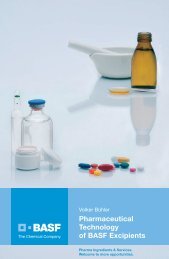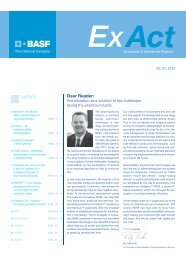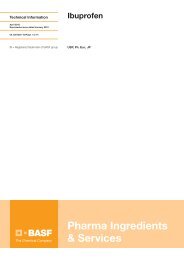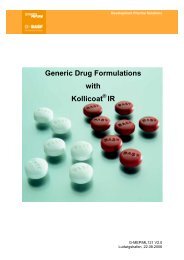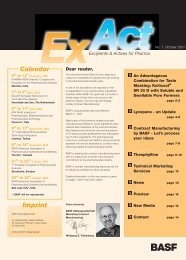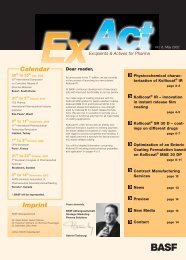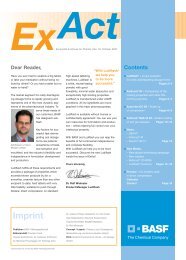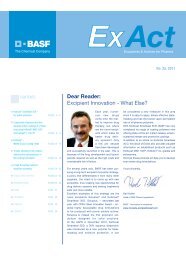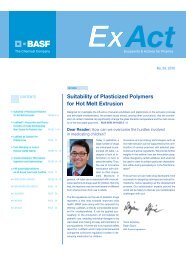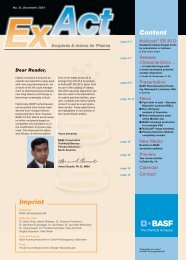Dear Reader: Innovations across the entire package - Pharma ...
Dear Reader: Innovations across the entire package - Pharma ...
Dear Reader: Innovations across the entire package - Pharma ...
Create successful ePaper yourself
Turn your PDF publications into a flip-book with our unique Google optimized e-Paper software.
Excipients & Actives for <strong>Pharma</strong><br />
No. 26, 2011<br />
CONTENTS<br />
<strong>Dear</strong> <strong>Reader</strong>:<br />
<strong>Innovations</strong> <strong>across</strong> <strong>the</strong> <strong>entire</strong> <strong>package</strong><br />
Improving on a classic:<br />
<strong>the</strong> new PeroXeal packaging<br />
concept for Kollidon PAGES 2 – 4<br />
Binding properties and flow<br />
behavior of different<br />
crospovidone grades PAGES 5 – 7<br />
Modeling drug release from<br />
Kollidon ® SR controlled release<br />
matrix tablets PAGES 8 – 10<br />
Extended stabilization of active<br />
ingredients highly sensitive to<br />
oxidation using Kollidon 30 LP PAGES 11 – 12<br />
ExActMelt – improving drug<br />
efficiency with hot-melt extrusion PAGE 13<br />
CEP procedure and <strong>the</strong> availability<br />
of CEP for BASF products PAGES 14 – 16<br />
REGULATORY NEWS PAGES 17<br />
EVENTS PAGE 18<br />
BREAKING NEWS PAGE 19<br />
CALENDAR PAGE 20<br />
PREVIEW PAGE 20<br />
New and innovative<br />
excipients are required<br />
to meet today’s increasing<br />
challenges<br />
in <strong>the</strong> formulation of<br />
new drugs and dosage<br />
forms. Products<br />
such as our Soluplus ®<br />
or Kollicoat ® Smartseal<br />
30 D have <strong>the</strong>refore<br />
been successfully introduced<br />
to meet challenges like <strong>the</strong> poor solubility<br />
of APIs or effective taste masking. But do<br />
we always need to use new excipients? How<br />
can we fur<strong>the</strong>r broaden <strong>the</strong> application range of<br />
well-established excipients?<br />
By looking at <strong>the</strong> <strong>entire</strong> “<strong>package</strong>” of our<br />
Kollidon products, we were able to significantly<br />
improve <strong>the</strong> quality and broaden <strong>the</strong> application<br />
range of our binders and disintegrants. With<br />
our latest improvement - <strong>the</strong> new PeroXeal<br />
packaging concept - we not only maintain high<br />
purity levels over a longer period of time, extending<br />
shelf life; we also open up new application<br />
fields for povidone binders and disintegrants<br />
– for example, in <strong>the</strong> field of oxygen-sensitive<br />
APIs. In addition, <strong>the</strong> new PeroXeal packaging<br />
concept allows easier and safer handling<br />
and is better for <strong>the</strong> environment. Since inventing<br />
"Kollidon - <strong>the</strong> Original" 70 years ago, we<br />
continue to innovate and set new standards in<br />
stability, purity and patient safety.<br />
The new PeroXeal packaging concept is an excellent<br />
example of BASF’s continuous pursuit of<br />
innovation, both for new and established products.<br />
To improve <strong>the</strong> usability of our ingredients<br />
for customers, we have optimized <strong>the</strong> <strong>entire</strong><br />
"<strong>package</strong>" – from ordering <strong>the</strong> product, to processability<br />
(e.g. flow behaviour) and even to disposal<br />
of <strong>the</strong> packaging.<br />
Yours sincerely,<br />
Boris Jenniches<br />
Head of Global Product Management <strong>Pharma</strong> Ingredients & Services<br />
Kollidon – The Original<br />
www.kollidon.com<br />
CONTACT PAGE 20
Excipients & Actives for <strong>Pharma</strong><br />
No. 26, 2011<br />
IN FOCUS: KOLLIDON PACKAGING<br />
Improving on a classic: <strong>the</strong> new PeroXeal <br />
packaging concept for Kollidon ®<br />
Silvia Mok, Claudia Easterbrook, Bernhard Fussnegger<br />
PUBLISHER:<br />
BASF SE<br />
<strong>Pharma</strong> Ingredients & Services<br />
www.pharma-ingredients.basf.com<br />
EDITORIAL STAFF:<br />
Ralf Fink<br />
Andres-Christian Orthofer<br />
Karl Kolter<br />
Jan Bebber<br />
AUTHORS:<br />
Angelika Maschke<br />
Bernhard Fussnegger<br />
Claudia Easterbrook<br />
CorinnaTissen<br />
Cecil Tung<br />
Dominik Odenbach<br />
Florence Siepmann<br />
Janna Lorenz<br />
Jürgen Siepmann<br />
Karl Kolter<br />
Kathrin Meyer-Böhm<br />
Karin Eckart<br />
Marcel Hilkens<br />
Peter Kleinebudde<br />
Rainer Fendt<br />
Ralf Hadeler<br />
Silvia Mok<br />
CONCEPT/LAYOUT:<br />
Château Louis Strategische Markenführung<br />
und Kommunikation GmbH<br />
PRINT:<br />
ABOUT US<br />
johnen-druck GmbH & Co. KG<br />
Kollidon enjoys a long and rich tradition.<br />
BASF scientist Walter Reppe invented polyvinylpyrrolidone<br />
(PVP) over 70 years ago, and we registered<br />
its first pharmaceutical applications in <strong>the</strong><br />
1950s – making us <strong>the</strong> most experienced team in<br />
<strong>the</strong> industry. Manufactured to <strong>the</strong> most exacting<br />
of quality standards in a world-class plant, <strong>the</strong><br />
Kollidon product family comprises soluble and<br />
insoluble grades of polyvinylpyrrolidone of various<br />
molecular weights and particle sizes, a vinylpyrrolidone/vinyl<br />
acetate copolymer and a blend<br />
of polyvinyl acetate and polyvinylpyrrolidone.<br />
BASF has a range of Kollidon products for applications<br />
<strong>across</strong> <strong>the</strong> pharmaceutical sector: this<br />
versatile excipient can be deployed as a binder,<br />
disintegrant, bioavailability enhancer, film former,<br />
solubilizer, lyophilisation agent, suspension stabilizer,<br />
wetting agent, adhesive, stabilizer, intermediate,<br />
thickener, dissolution enhancer, and<br />
ppm<br />
toxicity reducing agent. And new uses are being<br />
discovered all <strong>the</strong> time, as BASF innovates to address<br />
customer challenges – continuously setting<br />
new standards in stability, purity and patient<br />
safety.<br />
The groundbreaking PeroXeal packaging concept<br />
now marks <strong>the</strong> next stage in <strong>the</strong> evolution<br />
of Kollidon. Previously, <strong>the</strong> standard market<br />
packaging comprised tie-wrapped polyethylene<br />
inner liners with an air-filled headspace. As a result,<br />
<strong>the</strong> excipient was easily contaminated by<br />
oxygen, allowing peroxide to form. The use of<br />
aluminum in <strong>the</strong> liner also led to problems, as<br />
flakes sometimes made <strong>the</strong>ir way into <strong>the</strong> product.<br />
Witnessing <strong>the</strong> impact of <strong>the</strong>se flaws on PVP<br />
stability and performance, <strong>the</strong> BASF experts<br />
continuously challenged <strong>the</strong>mselves to develop<br />
and enhance Kollidon packaging.<br />
Long-term stability data shows advantages<br />
1. Re-test period of <strong>package</strong>d material can be extended from 36 to 48 months<br />
2. Peroxide level is decreased to below 100 ppm<br />
Povidone K30 in<br />
standard market<br />
450<br />
packaging<br />
Compendial limit<br />
400<br />
350<br />
300<br />
Kollidon 30 in<br />
250<br />
standard BASF<br />
200<br />
packaging<br />
150<br />
Kollidon 30<br />
100<br />
in new BASF<br />
50<br />
packaging<br />
0<br />
0 1 3 6 9 12 18 24 36 48<br />
Months<br />
Trademarks are owned by BASF SE<br />
FIGURE 1<br />
Comparison of stability data<br />
Page 2
Excipients & Actives for <strong>Pharma</strong><br />
No. 26, 2011<br />
The hard work paid off: years of research and<br />
analysis have culminated in BASF’s new proprietary<br />
aluminum-free PeroXeal packaging concept.<br />
The innovative foil comprises three distinct functional<br />
layers, each specifically designed to shield<br />
<strong>the</strong> product from environmental influences. Complemented<br />
by inert gas flushing and heat sealing,<br />
<strong>the</strong> packaging significantly reduces peroxide<br />
levels and eliminates <strong>the</strong> risk of contamination<br />
with aluminum flakes – at no additional cost to<br />
<strong>the</strong> customer.<br />
The PeroXeal edge has allowed BASF to raise<br />
<strong>the</strong> bar even fur<strong>the</strong>r in <strong>the</strong> PVP market. By preventing<br />
degradation of <strong>the</strong> excipients’ superior<br />
quality and incredible freshness, <strong>the</strong> packaging<br />
concept has increased Kollidon’s shelf life to<br />
four years. So worrying about peroxide levels, K<br />
values and API degradation is a thing of <strong>the</strong> past.<br />
FIGURE 2<br />
No degradation of K value<br />
(Usual decrease of K value in contact with air is around<br />
0.2 units per month)<br />
k-value<br />
94<br />
92<br />
Kollidon 90F in<br />
90<br />
88<br />
standard BASF<br />
packaging<br />
86<br />
84<br />
82<br />
Povidone K90 in<br />
standard market<br />
packaging<br />
80<br />
0 1 3 6 9 12 18 24 36 48<br />
Comparison of K values<br />
Months<br />
Kollidon 90F<br />
in new BASF<br />
packaging<br />
The groundbreaking<br />
PeroXeal packaging<br />
concept now marks <strong>the</strong><br />
next stage in <strong>the</strong> evolution<br />
of Kollidon.<br />
FIGURE 3<br />
Transparent aluminum-free packaging avoids product contamination with aluminum flakes<br />
Page 3
Excipients & Actives for <strong>Pharma</strong><br />
No. 26, 2011<br />
The most immediate benefit is consistent performance<br />
in terms of binding, viscosity and adhesion<br />
– plus enhanced stability opens <strong>the</strong> door for<br />
<strong>entire</strong>ly new applications.<br />
Formulation with<br />
sensitive APIs<br />
Formulation<br />
stability<br />
For example, you can now use Kollidon ® as an<br />
alternative to cellulose when working with oxygen-sensitive<br />
ingredients. What’s more, <strong>the</strong><br />
transparent inner lining is compatible with NIR<br />
testing – so packaging can remain sealed until<br />
<strong>the</strong> product is actually being used, retaining<br />
Kollidon’s original freshness. Thanks to<br />
PeroXeal, <strong>the</strong> best PVP portfolio on <strong>the</strong> market<br />
just got even better.<br />
Opens new opportunities for<br />
formulation with 0 2 -sensitive APIs<br />
Greater choice<br />
Provides an alternative to cellulose<br />
Greater<br />
choice<br />
Formulation<br />
with sensitive<br />
APIs<br />
Longer<br />
shelf life<br />
Formulation<br />
stability<br />
Allows stable formulaions by<br />
reduced API degradation<br />
constant K values<br />
Improved performance and<br />
reliability<br />
Longer shelf life<br />
Extends excipient shelf life up<br />
to 4 years<br />
FIGURE 4<br />
Benefits of <strong>the</strong> new packaging concept to our customers<br />
Page 4
Excipients & Actives for <strong>Pharma</strong><br />
No. 26, 2011<br />
CROSPOVIDONE<br />
Binding properties and flow behavior of<br />
different crospovidone grades<br />
C.Tissen, M.Hilkens, J.Lorenz, P.Kleinebudde Institute of <strong>Pharma</strong>ceutics and Biopharmaceutics, Heinrich-Heine-University Duesseldorf, Germany<br />
INTRODUCTION | Crospovidone is a superdisintegrant<br />
commonly used in quantities of 2-5 %<br />
(w/w) to accelerate <strong>the</strong> disintegration of tablets.<br />
Several grades of Kollidon CL are commercially<br />
available and differ only in particle size distribution.<br />
The drawbacks of traditional disintegrants<br />
are often poor flowability or a negative influence<br />
on <strong>the</strong> compactibility of tableting mixtures.<br />
However, robust mechanical properties and low<br />
friability should be achieved in order to facilitate<br />
fur<strong>the</strong>r production steps, e.g. coating processes.<br />
Therefore, a combination of a dry binder and a<br />
disintegrant is often required to improve <strong>the</strong><br />
mech anical properties of a tablet while still ensuring<br />
complete disintegration.<br />
The purpose of this study was to investigate <strong>the</strong><br />
binding properties of crospovidone grades of<br />
different particle size distributions and elucidate<br />
<strong>the</strong>ir influence on tensile strength.<br />
METHODS AND MATERIALS | Materials<br />
Crospovidone (Kollidon CL, Kollidon CL-F,<br />
Kollidon CL-SF, BASF SE, Ludwigshafen, Germany),<br />
alpha-lactose monohydrate (Tablettose ®<br />
80, Meggle, Wasserburg, Germany), dicalcium<br />
phosphate (Dicaphos ® AN, *Budenheim, Germany),<br />
magnesium stearate (Welding, Hamburg,<br />
Germany).<br />
Methods / Particle size distribution The particle<br />
size distribution of <strong>the</strong> various Kollidon CL<br />
grades was analyzed using laser light diffraction<br />
(Helos, Sympatec GmbH, Clausthal-Zellerfeld,<br />
Germany). Measurements were performed in<br />
triplicate with a dry dispersing unit (Vibri, Rhodos<br />
T4.1, Sympatec GmbH, Claustha-Zellerfeld,<br />
Germany) at 1.0 bar.<br />
Flowability The flowability of <strong>the</strong> tabletting mixtures<br />
was analyzed in duplicate with a ring shear<br />
tester (RST-01.c, RST-CONTROL 95 Schulze<br />
Schuettguttechnik, Wolfenbuettel, Germany).<br />
Consolidation stress and unconfined yield<br />
strength were used to characterize flowability.<br />
Normal stress during pre-shearing was 5000 Pa.<br />
Compression of tablets Table 1 shows tabletting<br />
mixtures containing different ratios of filler<br />
(Tablettose 80, Dicaphos AN) and disintegrant<br />
(Kollidon CL; Kollidon CL-F, Kollidon CL-SF).<br />
Each formulation was blended for 20 minutes in<br />
a laboratory-scale Turbula mixer (Turbula T2F,<br />
Bachofen AG Maschinenfabrik, Basel, Switzerland).<br />
Afterwards, 0.5% w/w magnesium stearate<br />
was added as a lubricant and <strong>the</strong> mixtures were<br />
blended for two fur<strong>the</strong>r minutes.<br />
Each mixture was compressed to flat-faced tablets<br />
of 12 mm diameter at 153 and 255 MPa, using<br />
a rotary die press (Pressima, IMA Kilian, Cologne,<br />
Germany). Crushing forces were determined with<br />
a hardness tester (HT-1, Sotax, Basel, Switzerland)<br />
and subsequently calculated as tensile<br />
strength according to Fell and Newton [1].<br />
TABLE 1<br />
Fraction [%]<br />
Filler 100 95 90 80 60 40 0<br />
Disintegrant 0 5 10 20 40 60 100<br />
Tabletting mixtures<br />
Disintegration testing The disintegration time<br />
for 12 tablets of each batch was measured with<br />
a disintegration tester (Erweka ZT 32, Heusenstamm,<br />
Germany) according to Ph.Eur. Because<br />
of <strong>the</strong> extreme turbidity of <strong>the</strong> disintegration<br />
medium after a few seconds, all batches were<br />
analyzed without using a beaker.<br />
RESULTS AND DISCUSSION | Discussion<br />
The tensile strength of <strong>the</strong> lactose/crospovidone<br />
tablets varied from 0.9 to 5.1 N/mm² (Figure 1).<br />
Irrespective of <strong>the</strong> amount of Kollidon CL, <strong>the</strong><br />
tablets exhibited no increase in tensile strength.<br />
In contrast, crospovidone grades with smaller<br />
particle sizes led to improved tensile strength.<br />
The higher <strong>the</strong> amount of Kollidon CL-F and<br />
Kollidon CL-SF, <strong>the</strong> higher <strong>the</strong> tensile strength<br />
of <strong>the</strong> resulting tablets. As <strong>the</strong> particle size of<br />
crospovidone decreased, <strong>the</strong> detected tensile<br />
strength increased (Figure 2). The tensile strength<br />
of tablets is known to be affected by <strong>the</strong> variation<br />
in particle size of <strong>the</strong> excipients used. Smaller<br />
particles facilitate interparticulate bonding during<br />
<strong>the</strong> compression process, resulting in tablets<br />
with improved hardness [2]. Consequently, tablets<br />
with Kollidon CL-SF exhibited <strong>the</strong> highest<br />
values. Even 20% (w/w) almost doubled <strong>the</strong> determined<br />
tensile strength.<br />
All crospovidone grades could successfully<br />
be compressed to tablets without filler; tablets<br />
consisting of pure Kollidon CL-SF exhibited <strong>the</strong><br />
highest tensile strength.<br />
Page 5
Excipients & Actives for <strong>Pharma</strong><br />
No. 26, 2011<br />
To investigate <strong>the</strong> influence of <strong>the</strong> type of filler,<br />
tablets with varying ratios of crospovidone grades<br />
and dicalcium phosphate anhydrate as filler<br />
were compressed (Figure 3). Again, <strong>the</strong> resulting<br />
tensile strength of <strong>the</strong> tablets depended on <strong>the</strong><br />
grade and amount of <strong>the</strong> crospovidone used.<br />
The tablets containing Kollidon ® CL did not show<br />
an increase in tensile strength, whereas those<br />
containing Kollidon CL-F and Kollidon CL-SF<br />
showed increasing values. The increase was<br />
more pronounced for tablets made with dicalcium<br />
phosphate anhydrate compared to those<br />
containing lactose.<br />
Tensile strength [N/mm 2 ]<br />
6<br />
5<br />
4<br />
3<br />
2<br />
1<br />
Lactose / Kollidon CL-SF<br />
Lactose / Kollidon CL-F<br />
Lactose / Kollidon CL<br />
In addition to good binder properties, tabletting<br />
excipients for direct compression should exhibit<br />
good flowability. All formulations were analyzed<br />
with a ring shear tester; <strong>the</strong> detected flow behavior<br />
is depicted in Figure 4, where different<br />
regions represent bulk flowability from very cohesive<br />
to free-flowing. Each tabletting mixture<br />
exhibited at least easy-flowing behavior. By adding<br />
different grades and ratios of crospovidone<br />
to lactose, flowability changed from free-flowing<br />
to easy-flowing. Kollidon CL-SF, which has <strong>the</strong><br />
smallest particle size, led to formulations with <strong>the</strong><br />
worst flowability. However, all analyzed tabletting<br />
mixtures still exhibited easy-flowing or free-flowing<br />
behavior. Adding Kollidon CL-SF produces a<br />
minor effect only on flow properties; this can be<br />
neglected during compression. For every batch,<br />
all analyzed tablets disintegrated disintegrated in<br />
less than 70 seconds.<br />
0<br />
FIGURE 1 Tensile strength of lactose/crospovidone tablets compressed at 255 MPa. (n = 10, mean ± s)<br />
Cumulative fraction [%]<br />
0 20 40 60 80 100<br />
100<br />
80<br />
60<br />
40<br />
Kollidon CL<br />
Kollidon CL-F<br />
Kollidon CL-SF<br />
Disintegrant [%]<br />
20<br />
0<br />
1 10 100 1000<br />
Particle size [µm]<br />
FIGURE 2 Particle size distributions of Kollidon CL, CL-F and CL-SF, measured with laser light diffraction. (n = 3)<br />
Page 6
Excipients & Actives for <strong>Pharma</strong><br />
No. 26, 2011<br />
Tensile strength [N/mm 2 ]<br />
6<br />
5<br />
4<br />
3<br />
2<br />
1<br />
Lactose / Kollidon CL<br />
Lactose / Kollidon CL-F<br />
Lactose / Kollidon CL-SF<br />
Dicalcium phosphate anh. / Kollidon CL<br />
Dicalcium phosphate anh. / Kollidon CL-F<br />
Dicalcium phosphate anh. / Kollidon CL-SF<br />
Conclusion Crospovidone grades of small particle<br />
size can be used as combined disintegrants<br />
and binders. The tensile strength of <strong>the</strong> directly<br />
compressed tablets was almost tripled, depending<br />
on particle size and amount of crospovidone<br />
used. In addition to <strong>the</strong> dry binder properties, all<br />
mixtures containing different grades and ratios<br />
of crospovidone exhibited at least easy-flowing<br />
behavior. The combination of dry binder properties<br />
and easy-flowing behavior makes crospovidone<br />
an ideal excipient for direct compression.<br />
REFERENCES<br />
0<br />
0 20 40 60 80 100<br />
Disintegrant [%]<br />
[1] Fell, J.T., Newton, J.M., (1970)."Determination<br />
of tablet strength by <strong>the</strong> diametral-compression<br />
test", Journal of <strong>Pharma</strong>ceutical Sciences<br />
59 (5): 688-691.<br />
FIGURE 3<br />
Tensile strength of lactose/crospovidone and dicalcium phosphate anh./crospovidone tablets compressed at<br />
153 MPa. (n = 10; mean ± s)<br />
[2] McKenna, A. (1982). “Effect of particle size<br />
on <strong>the</strong> compaction mechanism and tensile<br />
strength of tablets.” Journal of <strong>Pharma</strong>cy and<br />
<strong>Pharma</strong>cology 34(6): 347-351.<br />
3000<br />
Very<br />
cohesive<br />
ff c =2<br />
Cohesive<br />
Unconfined yield strength [Pa]<br />
2000<br />
1000<br />
ff c =4<br />
Easy-flowing<br />
ff c =10<br />
Free-flowing<br />
0<br />
5000 7500 10000<br />
Consolidation stress [Pa]<br />
FIGURE 4<br />
Flowability of tabletting mixtures with different ratio of disintegrant. (blue symbols = Kollidon® CL-SF,<br />
red symbols = Kollidon® CL-F, green symbols = Kollidon® CL, black symbols = pure lactose)<br />
Page 7
Excipients & Actives for <strong>Pharma</strong><br />
No. 26, 2011<br />
CONTROLLED RELEASE<br />
Modeling drug release from Kollidon ® SR controlled<br />
release matrix tablets<br />
F. Siepmann,1 K. Eckart,1 A. Maschke,2 K. Kolter,2 J. Siepmann1*<br />
1INSERM U 1008, College of <strong>Pharma</strong>cy, Univ. Lille Nord de France, 3 rue du Professeur Laguesse, 59006 Lille, France 2BASF, The Chemical Company, 67056 Ludwigshafen, Germany<br />
INTRODUCTION | In <strong>the</strong> development of<br />
controlled release formulations for oral drug<br />
delivery, matrix tablets play a major role. Among<br />
matrix materials, Kollidon SR, a blend of polyvinyl<br />
acetate and polyvinylpyrrolidone, has been designed<br />
for sustained release applications. To<br />
achieve <strong>the</strong> most suitable drug release profile, <strong>the</strong><br />
formulation scientist can vary <strong>the</strong> composition of<br />
<strong>the</strong> matrix formulation. Factors influencing drug<br />
release are <strong>the</strong> solubility of <strong>the</strong> drug, its physicochemical<br />
characteristics, <strong>the</strong> matrix former content<br />
as well as <strong>the</strong> drug load. To accelerate drug<br />
release, hydrophilic pore forming excipients such<br />
as copovidone can be used. To reduce <strong>the</strong> velocity<br />
of drug release, <strong>the</strong> absolute concentration<br />
of matrix material can be increased.<br />
Purpose The aim of this study was to better<br />
understand <strong>the</strong> mass transport mechanisms<br />
controlling drug release from Kollidon SR matrix<br />
tablets. Based on thorough experimental characterization,<br />
a mechanistic and realistic ma<strong>the</strong>matical<br />
model was to be developed and used to<br />
quantitatively predict <strong>the</strong> effects of tablet dimensions<br />
on drug release. This approach ena bles<br />
faster formulation development by calculating a<br />
desired release profile based on a minor set of<br />
release experiments.<br />
Based on this ma<strong>the</strong>matical<br />
approach, a drug<br />
release profile can be<br />
easily adapted to <strong>the</strong><br />
specific <strong>the</strong>rapeutic<br />
application.<br />
100<br />
a) b)<br />
Tablet characterization The tablets were exposed<br />
to 900 mL 0.1 M HCl or phosphate buffer<br />
pH 7.4 (USP 30) in a USP 30 rotating paddle apparatus<br />
(37°C, 80 rpm). At predetermined points<br />
in time, 3 mL samples were withdrawn and<br />
ana lyzed spectrophotometrically for <strong>the</strong>ir drug<br />
content (λ=274 nm). Changes in tablet dimensions<br />
(radius and height) were monitored with an<br />
optical imaging system. The water uptake and<br />
weight loss kinetics of <strong>the</strong> tablets were determined<br />
gravimetrically.<br />
RESULTS AND DISCUSSION | Upon exposure<br />
to <strong>the</strong> release medium, <strong>the</strong> water content<br />
of <strong>the</strong> tablets increased rapidly and steeply but<br />
<strong>the</strong>n leveled off (Figure 1a). In contrast, <strong>the</strong> dry<br />
mass of <strong>the</strong> system continuously decreased<br />
throughout <strong>the</strong> observation period, and could essentially<br />
be attributed to drug release (Figure 1b).<br />
100<br />
EXPERIMENTAL METHODS | Tablet preparation<br />
Drug-free and diprophylline-loaded Kollidon<br />
SR-based tablets (0-60% w/w drug content, 1%<br />
colloidal SiO 2 , 0.5% magnesium stearate) were<br />
prepared by direct compression. The drug and<br />
polymer powder were blended and compressed<br />
with a single-punch tableting machine (flat-faced<br />
punches: 5, 11.3 or 16 mm in diameter). The hardness<br />
of <strong>the</strong> tablets was kept constant (180 N).<br />
Water content [%]<br />
75<br />
50<br />
25<br />
0<br />
60% diprophylline<br />
40%<br />
20%<br />
0%<br />
0 2 4 6 8<br />
Time [h]<br />
Dry mass [%]<br />
75<br />
50<br />
25<br />
0<br />
0% diprophylline<br />
20%<br />
40%<br />
60%<br />
0 2 4 6 8<br />
Time [h]<br />
FIGURE 1<br />
Effects of <strong>the</strong> initial diprophylline content on: (a) water uptake and (b) dry mass loss of Kollidon SR tablets upon<br />
exposure to phosphate buffer pH 7.4 (diameter = 11.3 mm). Reprinted from reference [1], with permission<br />
Page 8
Excipients & Actives for <strong>Pharma</strong><br />
No. 26, 2011<br />
Cross-sections of Kollidon SR tablets exposed<br />
for different time periods to 0.1 M HCl containing<br />
0.35% w/w methylene blue are shown in<br />
figure 2. Due to concentration gradients, <strong>the</strong><br />
dye continuously penetrated <strong>the</strong> tablets. Importantly,<br />
<strong>the</strong> penetration fronts appeared homogeneous<br />
and nei<strong>the</strong>r crack nor cavity formation<br />
was observed.<br />
At low and intermediate initial drug content, <strong>the</strong><br />
tablet height monotonically increased upon exposure<br />
to <strong>the</strong> release media, whereas at very<br />
high initial drug content, <strong>the</strong> tablet height decreased<br />
again after a certain lag time (figure 3).<br />
FIGURE 2<br />
Macroscopic pictures of cross-sections of Kollidon SR-based tablets upon exposure to 0.1 M HCl containing 0.35% w/w<br />
methylene blue for different time periods (as indicated) (initial diprophylline content: 20%). Reprinted from reference [1],<br />
with permission<br />
Increase in height [%]<br />
100<br />
75<br />
50<br />
25<br />
0<br />
0% diprophylline<br />
40%<br />
20%<br />
6%<br />
0 2 4 6 8<br />
Time [h]<br />
For tablets with an initial drug content below<br />
60% w/w, <strong>the</strong> following analytical solution<br />
of Fick’s second law of diffusion was used to<br />
quantify drug release from <strong>the</strong> investigated matrix<br />
tablets (considering axial as well as radial<br />
mass transfer in a cylinder) (equation 1), where<br />
M t and M ∞ represent <strong>the</strong> absolute cumulative<br />
amounts of drug released at time t and infinite<br />
time, respectively; <strong>the</strong> q n s are <strong>the</strong> roots of <strong>the</strong><br />
Bessel function of <strong>the</strong> first zero order, and R and<br />
H denote <strong>the</strong> initial radius and height of <strong>the</strong> cylinder.<br />
Figure 4 illustrates <strong>the</strong> good agreement<br />
obtained when fitting this <strong>the</strong>ory to <strong>the</strong> drug release<br />
patterns measured in experiments.<br />
FIGURE 3<br />
Effects of <strong>the</strong> initial diprophylline content on changes in <strong>the</strong> height of Kollidon SR tablets upon exposure to phosphate<br />
buffer pH 7.4 (diameter = 11.3 mm). Reprinted from reference [1], with permission<br />
Page 9
Excipients & Actives for <strong>Pharma</strong><br />
No. 26, 2011<br />
Based on <strong>the</strong>se calculations, <strong>the</strong> apparent diffusion<br />
coefficient of <strong>the</strong> drug in <strong>the</strong> polymeric<br />
matrix could be determined: D = 1.7, 2.4 and<br />
4.0 x 10 -7 cm²/s for 10, 20 and 40% initial drug<br />
content. Knowing <strong>the</strong>se values, <strong>the</strong> resulting<br />
drug release kinetics can be predicted for arbi trary<br />
tablet dimensions. One example is shown in<br />
figure 5 (dotted curves). These <strong>the</strong>oretical predictions<br />
could successfully be confirmed by<br />
independent experiments (symbols in figure 5).<br />
Equation 1<br />
M t<br />
M∞<br />
= 1-<br />
32<br />
π²<br />
·∑∞<br />
n=1<br />
Fick’s second law of diffusion<br />
1<br />
·exp<br />
q² ( -<br />
n<br />
R c<br />
q² n<br />
² ·D·t ) ·∑∞<br />
p=0<br />
1<br />
(2·p+1) 2 ·exp ( - (2·p+1)2· π²<br />
H ²<br />
·D·t<br />
)<br />
Conclusion Diprophylline release from Kollidon ®<br />
SR tablets is primarily controlled by diffusion. The<br />
ma<strong>the</strong>matical model presented allows for a facilitated<br />
optimization of this type of drug delivery<br />
system. Based on this ma<strong>the</strong>matical approach, a<br />
drug release profile can be easily adapted to <strong>the</strong><br />
specific <strong>the</strong>rapeutic application by reducing <strong>the</strong><br />
necessary experiments and hereby facilitating<br />
faster formulation development.<br />
REFERENCES<br />
[1] Siepmann, F; Eckart, K; Maschke, A; Kolter,<br />
K; Siepmann, J. Modeling drug release from<br />
PVAc/PVP matrix tablets. Journal of Controlled<br />
Release 141, 216-222, 2010.<br />
[2] J. Crank. The Ma<strong>the</strong>matics of Diffusion. Clarendon<br />
Press, Oxford, 1975.<br />
Drug released [%]<br />
100<br />
75<br />
50<br />
25<br />
0<br />
FIGURE 4<br />
40% diprophylline<br />
20%<br />
10%<br />
<strong>the</strong>ory<br />
0 6 12 18 24<br />
Time [h]<br />
Experiment (symbols) and <strong>the</strong>ory (curves):<br />
Diprophylline release from Kollidon SR tablets<br />
with different initial drug loadings in phosphate<br />
buffer pH 7.4. (diameter = 11.3 mm). Reprinted<br />
from reference [1], with permission<br />
Drug released [%]<br />
100<br />
75<br />
50<br />
25<br />
0<br />
FIGURE 5<br />
<strong>the</strong>oretical prediction<br />
1.3mm, experiment<br />
3.9mm, experiment<br />
0 6 12 18 24<br />
Time [h]<br />
Theoretical prediction (dotted curves) and independent<br />
experimental verification (symbols):<br />
Effects of <strong>the</strong> tablet height on diprophylline<br />
release from Kollidon SR tablets in phosphate<br />
buffer pH 7.4 (drug loading: 20%, diameter = 11.3 mm).<br />
Reprinted from reference [1], with permission<br />
Page 10
Excipients & Actives for <strong>Pharma</strong><br />
No. 26, 2011<br />
STABILITY OF FORMULATED OXYGEN-SENSITIVE ACTIVE INGREDIENTS<br />
Extended stabilization of active ingredients highly sensitive<br />
to oxidation using Kollidon 30 LP<br />
Angelika Maschke, Karl Kolter<br />
INTRODUCTION | <strong>Pharma</strong>ceutical formulators<br />
regularly require a low peroxide content in<br />
<strong>the</strong> excipients used to avoid degradation of <strong>the</strong><br />
active ingredients (APIs) used. BASF fulfils this<br />
need to <strong>the</strong> maximum extent with its high-quality<br />
Kollidon grades and <strong>the</strong> packaging concept<br />
introduced in this ExAct issue (see pages 2-4).<br />
Moreover, <strong>the</strong> formulation of drugs that are<br />
highly sensitive to oxidation has become an<br />
additional major challenge for formulation scientists.<br />
For this purpose, it is of <strong>the</strong> utmost importance<br />
to use excipients with an especially<br />
low peroxide content.<br />
Considering <strong>the</strong> close contact between active<br />
ingredients and excipients during wet granu lation<br />
or direct compression, <strong>the</strong> peroxide level of <strong>the</strong><br />
excipient has a strong impact on <strong>the</strong> stability<br />
of <strong>the</strong> API. As a first formulation approach, <strong>the</strong><br />
stability of <strong>the</strong> API in a binder solution allows<br />
<strong>the</strong> appropriate binder to be identified. The goal<br />
of this study was to investigate <strong>the</strong> effect of <strong>the</strong><br />
peroxide content of povidone on API stability in<br />
solution.<br />
Using Kollidon 30 LP in<br />
<strong>the</strong> formulation of actives<br />
highly sensitive to<br />
oxidation can significantly<br />
improve drug stability.<br />
Set-up of experiments The effect of Kollidon<br />
30 Low Peroxide in solution on stabilization<br />
against oxidation was investigated using ascorbic<br />
acid and hydrocortisone as model substances.<br />
Povidones of different peroxide content (see<br />
table 1) were used to prepare a 20% aqueous<br />
solution. Ascorbic acid was incorporated at a<br />
0.1% level and hydrocortisone at 0.025%.<br />
For <strong>the</strong> stability study, <strong>the</strong> samples were filled<br />
in glass vials incubated with or without argon,<br />
closed with a rubber cap and sealed with a<br />
cramp. The solutions were stored for 3 months at<br />
25°C and 60% relative humidity. The API content<br />
was determined by HPLC.<br />
Results Both drug substances showed higher<br />
stability in solutions prepared with Kollidon 30 LP.<br />
After 1 month in Kollidon 30 LP solution, <strong>the</strong><br />
ascorbic acid content was 50% vs. 30% in a<br />
PVP solution with a starting peroxide level of<br />
< 260ppm (Figure 1). A similar stabilization effect<br />
was found for hydrocortisone solutions<br />
(Figure 2).<br />
Povidone<br />
Peroxide content<br />
Kollidon 30 LP Very low < 20 ppm<br />
PVP 30 Low < 260 ppm<br />
PVP 30 Enriched 370 ppm<br />
TABLE 1<br />
Povidone grades used for preparing aqueous acid solutions<br />
Page 11
Excipients & Actives for <strong>Pharma</strong><br />
No. 26, 2011<br />
Solutions without argon<br />
Solutions with argon<br />
100<br />
100<br />
80<br />
Kollidon 30 LP<br />
80<br />
Ascorbic acid content [%]<br />
60<br />
40<br />
PVP<br />
PVP peroxide enriched<br />
Ascorbic acid<br />
60<br />
40<br />
20<br />
20<br />
0<br />
0 20 40 60 80 100<br />
0<br />
0 20 40 60 80 100<br />
Day<br />
Day<br />
FIGURE 1<br />
Stability of ascorbic acid in different povidone solutions incubated at 25°C /60% r.h.<br />
Hydrocortisone [%]<br />
100<br />
98<br />
96<br />
94<br />
Solutions without argon<br />
Conclusion<br />
• Using Kollidon ® 30 LP in <strong>the</strong> formulation of<br />
actives highly sensitive to oxidation can significantly<br />
improve drug stability.<br />
• A correlation was found between <strong>the</strong> peroxide<br />
content and <strong>the</strong> stability of <strong>the</strong> model actives.<br />
• Fur<strong>the</strong>r investigations to underline <strong>the</strong> effectiveness<br />
of Kollidon 30 LP in a dry state will<br />
be reported soon.<br />
92<br />
Kollidon 30 LP<br />
PVP<br />
PVP peroxide enriched<br />
90<br />
0 20 40 60 80 100<br />
Day<br />
FIGURE 2<br />
Stability of hydrocortisone in different povidone solutions incubated at 25°C /60% r.h.<br />
Page 12
Excipients & Actives for <strong>Pharma</strong><br />
No. 26, 2011<br />
HOT MELT EXTRUSION<br />
ExActMelt - improving drug efficiency with hot-melt extrusion<br />
Cecil Tung<br />
More than 70 pharmaceutical customers and<br />
R&D professionals ga<strong>the</strong>red in Singapore for <strong>the</strong><br />
two-day ExActMelt workshop to explore <strong>the</strong> innovative<br />
hot-melt extrusion technology. Contributing<br />
to <strong>the</strong> development of <strong>the</strong> talent pool for <strong>the</strong><br />
pharmaceutical industry, workshop participants<br />
also witnessed BASF extend its “Joint RP-BASF<br />
<strong>Pharma</strong>ceutical Technology Lab Program” with<br />
Republic Polytechnic.<br />
BASF and high-tech pharmaceutical equipment<br />
supplier ThermoFisher teamed up again for a<br />
closer look at Hot-Melt Extrusion (HME), an innovative<br />
technology for processing poorly soluble<br />
active pharmaceutical ingredients. The highly<br />
interactive two-day workshop at Republic Polytechnic<br />
in Singapore provided a much needed<br />
opportunity for intensive knowledge exchange<br />
between innovative excipient designers and manufacturers<br />
– a must for any new technology.<br />
<strong>Pharma</strong>ceutical customers from more than 10<br />
Asian countries participated in <strong>the</strong> workshop to<br />
learn more about this state-of-<strong>the</strong>-art technology<br />
that dramatically improves <strong>the</strong> bioavailability of<br />
active pharmaceutical ingredients. Providing a<br />
detailed insight into how <strong>the</strong> technology works<br />
and how it can help pharmaceutical processing,<br />
<strong>the</strong> workshop demonstrated that, combined with<br />
Thermo Fisher’s HME machine, BASF’s solubilizers<br />
such as Soluplus ® offer superior performance<br />
in forming solid solutions during <strong>the</strong> HME process.<br />
The combination of<br />
<strong>the</strong>oretical lectures<br />
and practical, hands-on<br />
demonstrations allowed<br />
customers to explore<br />
hot-melt extrusion in<br />
depth.<br />
“The combination of <strong>the</strong>oretical lectures and practical,<br />
hands-on demonstrations allowed customers<br />
to explore hot-melt extrusion in depth and<br />
make <strong>the</strong>m aware of <strong>the</strong> potential to improve bioavailability<br />
and patient compliance. Additionally,<br />
<strong>the</strong> workshop was a great opportunity for customers<br />
and R&D professionals to meet and discuss<br />
burning issues in <strong>the</strong> pharmaceutical industry,”<br />
said Thomas Pilgram, Regional Head of BASF<br />
<strong>Pharma</strong> Ingredients & Services in Asia Pacific.<br />
During <strong>the</strong> workshop, BASF also officially renewed<br />
<strong>the</strong> “Joint RP-BASF <strong>Pharma</strong>ceutical Technology<br />
Lab Program” with Republic Polytechnic, continuing<br />
to foster students’ interest in pharmaceutical<br />
technology and research. Through <strong>the</strong> program,<br />
pharmaceutical technologists and scientists will<br />
be trained and made aware of BASF’s innovative<br />
excipient development pipeline, underlining <strong>the</strong><br />
company's commitment to building up <strong>the</strong> talent<br />
pool for <strong>the</strong> industry.<br />
BASF will continue to explore opportunities for<br />
cooperating with universities and institutions<br />
similar to Republic Polytechnic. In addition, <strong>the</strong><br />
company will continue to establish its links with<br />
research centers and science institutes as well<br />
as leading pharmaceutical companies.<br />
The panel discussion was a great opportunity for pharmaceutical professionals to discuss<br />
burning issues within <strong>the</strong> industry.<br />
“Joint RP-BASF <strong>Pharma</strong>ceutical Technology Lab Program” Memorandum Of Understanding<br />
signing ceremony demonstrates BASF’s commitment to sustainable development with <strong>the</strong> goal<br />
of increasing collective expertise, experience and resources for <strong>the</strong> pharmaceutical industry.<br />
Page 13
Excipients & Actives for <strong>Pharma</strong><br />
No. 26, 2011<br />
REGULATORY NEWS<br />
CEP procedure and <strong>the</strong> availability of CEP for BASF products<br />
Dominik Odenbach<br />
In order to guarantee consistent product<br />
quality, pharmaceutical manufacturers must be<br />
able to demonstrate standardized, reliable quality<br />
of pharmaceutical ingredients in line with existing<br />
pharmaceutical monographs. To ensure<br />
quality, <strong>the</strong> Certification Secretariat of <strong>the</strong> European<br />
Directorate for <strong>the</strong> Quality of Medicines<br />
(EDQM) grants Certificates of Suitability of<br />
Monographs of <strong>the</strong> European <strong>Pharma</strong>copoeia<br />
(CEP) to manufacturers who can show that <strong>the</strong>ir<br />
production is compliant with <strong>the</strong> existing<br />
pharmaceutical monograph of <strong>the</strong> European<br />
<strong>Pharma</strong>copoeia. To apply for this certificate,<br />
pharma ceutical ingredients manufacturers must<br />
present a comprehensive dossier, including information<br />
on chemistry, manufacturer, process,<br />
characterization, controls, reference standards,<br />
container closure systems, stability.<br />
The CEP procedure was created in 1994. CEPs<br />
are accepted in all 36 member states of <strong>the</strong><br />
European <strong>Pharma</strong>copoeia Convention. According<br />
to <strong>the</strong> EDQM, non-European countries also<br />
accept CEP (e.g. Argentina, Brazil, Malaysia,<br />
Mexico, New Zealand, Russian Federation,<br />
Singa pore, South Africa, Taiwan, and o<strong>the</strong>rs).<br />
The CEP procedure has many advantages:<br />
• Efficiency through centralization<br />
Only <strong>the</strong> EDQM reviews <strong>the</strong> applications and<br />
grants CEPs. A DMF must be reviewed by<br />
indi vidual health authorities, but <strong>the</strong> CEP<br />
procedure is a single centralized evaluation.<br />
There is no duplication of work. Potential<br />
diver gences in assessment are avoided.<br />
• Less documentation<br />
Once granted, <strong>the</strong> CEP is only a few pages<br />
long whereas a DMF is a dossier with a large<br />
volume of documentation, which must be<br />
reviewed with each new registration.<br />
• Speed<br />
The information provided in <strong>the</strong> dossier is<br />
approved by <strong>the</strong> EDQM only once, with <strong>the</strong><br />
granting of a CEP. After this, each CEPbased<br />
registration is processed quickly.<br />
• IP protection<br />
The CEP dossier is only reviewed by one<br />
pub lic regulatory body (EDQM).<br />
Customer benefits<br />
For <strong>the</strong> pharmaceutical manufacturer, <strong>the</strong> CEP<br />
makes it easier to assess suppliers and <strong>the</strong>ir<br />
materials, without <strong>the</strong> need for conducting timeconsuming<br />
and costly audits. Marketing authorizations<br />
are easier to manage because CEP<br />
replaces <strong>the</strong> majority of <strong>the</strong> application.<br />
For <strong>the</strong> pharmaceutical<br />
manufacturer, <strong>the</strong> CEP<br />
makes it easier to assess<br />
suppliers and <strong>the</strong>ir materials,<br />
without <strong>the</strong> need for<br />
conducting time-consuming<br />
and costly audits.<br />
BASF is seeking to achieve CEP for its active<br />
ingredients and selected excipients. This will<br />
allow <strong>the</strong> company to supply customers with<br />
products compliant with <strong>the</strong> quality standards<br />
of <strong>the</strong> European <strong>Pharma</strong>copoeia. Plus, customers<br />
will benefit from a straightforward service<br />
solution.<br />
All of <strong>the</strong> following products have valid status<br />
and are classified under type chemistry (table 1):<br />
Time and cost<br />
The CEP procedure saves time (fixed time<br />
frames; a single regulatory body) and cuts costs<br />
for <strong>the</strong> industry and <strong>the</strong> licensing authorities. A<br />
CEP costs a one-off fee of approx. 3,000 euros,<br />
whereas a DMF will have to be provided to different<br />
health authorities, leading to multiple fees.<br />
Page 14
Excipients & Actives for <strong>Pharma</strong><br />
No. 26, 2011<br />
Substance<br />
number Substance Certificate holder Certificate number Issue date<br />
1385 Acitretin BASF SE DE 67056 Ludwigshafen<br />
R0-CEP 2007-201-<br />
Rev 01<br />
22/01/2009<br />
1688 Articaine hydrochloride<br />
BASF PHARMA (EVIONNAZ) SA CH<br />
1902 Evionnaz<br />
R1-CEP 2002-198-<br />
Rev 01<br />
13/07/2010<br />
541 Bupivacaine hydrochloride<br />
BASF PHARMA (EVIONNAZ) SA CH<br />
1902 Evionnaz<br />
R1-CEP 2004-043-<br />
Rev 01<br />
13/07/2010<br />
267 Caffeine<br />
BASF <strong>Pharma</strong>Chemikalien GmbH &<br />
Co. KG DE 67056 Ludwigshafen<br />
R1-CEP 1998-022-<br />
Rev 02<br />
16/12/2009<br />
543 Carbamazepine<br />
BASF PHARMA (EVIONNAZ) SA CH<br />
1902 Evionnaz<br />
891 Copovidone nominal K value 28 BASF SE DE 67056 Ludwigshafen<br />
892 Crospovidone type A and B<br />
BASF SE DE 67056 Ludwigshafen<br />
Am Rhein<br />
761 Dexpan<strong>the</strong>nol BASF SE DE 67056 Ludwigshafen<br />
1200 Dobutamine hydrochloride<br />
664 Dopamine hydrochloride<br />
487 Ephedrine hydrochloride<br />
BASF <strong>Pharma</strong>Chemikalien GmbH &<br />
Co. KG DE 67056 Ludwigshafen<br />
BASF <strong>Pharma</strong>Chemikalien GmbH &<br />
Co. KG DE 67056 Ludwigshafen<br />
BASF <strong>Pharma</strong>Chemikalien GmbH &<br />
Co. KG DE 67056 Ludwigshafen<br />
721 Ibuprofen BASF Corporation US 78343 Bishop<br />
1019 Isotretinoin BASF SE DE 67056 Ludwigshafen<br />
2052 Macrogol 15 hydroxystearate BASF SE DE 67056 Ludwigshafen<br />
1242 Mepivacaine hydrochloride<br />
1354 Oxybutynin hydrochloride<br />
BASF PHARMA (EVIONNAZ) SA CH<br />
1902 Evionnaz<br />
BASF PHARMA (EVIONNAZ) SA CH<br />
1902 Evionnaz<br />
0.9 R1-CEP 1998-<br />
086-Rev 04<br />
R0-CEP 2007-106-<br />
Rev 00<br />
R0-CEP 2007-076-<br />
Rev 00<br />
R0-CEP 2006-233-<br />
Rev 00<br />
R0-CEP 2006-273-<br />
Rev 01<br />
R0-CEP 2007-049-<br />
Rev 00<br />
R0-CEP 2006-234-<br />
Rev 00<br />
R1-CEP 2000-087-<br />
Rev 01<br />
R1-CEP 1999-068-<br />
Rev 03<br />
R0-CEP 2006-095-<br />
Rev 02<br />
R1-CEP 2001-305-<br />
Rev 02<br />
R1-CEP 2000-108-<br />
Rev 03<br />
13/07/2010<br />
10/10/2008<br />
10/10/2008<br />
04/11/2008<br />
27/04/2010<br />
27/04/2010<br />
16/01/2008<br />
18/07/2008<br />
07/06/2011<br />
17/11/2008<br />
13/07/2010<br />
13/07/2010<br />
TABLE 1<br />
BASF products for which CEP is available<br />
Page 15
Excipients & Actives for <strong>Pharma</strong><br />
No. 26, 2011<br />
943 Oxymetazoline hydrochloride<br />
1142 Povidone, iodinated<br />
685<br />
685<br />
Povidone 'nominal K value 12' &<br />
'nominal K value 17'<br />
Povidone 'nominal K value 25' and<br />
'nominal K value 30'<br />
685 Povidone 'nominal K value 90'<br />
1362 Prilocaine<br />
1363 Prilocaine hydrochloride<br />
1367 Pseudoephedrine hydrochloride<br />
1260 Selegiline hydrochloride<br />
299 Theophylline<br />
302 Theophylline monohydrate<br />
300<br />
301<br />
Theophylline-ethylenediamine<br />
anhydrous<br />
Theophylline-ethylenediamine<br />
hydrate<br />
1767 Tilidine hydrochloride hemihydrate<br />
BASF <strong>Pharma</strong>Chemikalien GmbH &<br />
Co. KG DE 67056 Ludwigshafen<br />
BASF CORPORATION US 07932 Florham<br />
Park<br />
BASF SE DE 67056 Ludwigshafen<br />
Am Rhein<br />
BASF SE DE 67056 Ludwigshafen<br />
Am Rhein<br />
BASF SE DE 67056 Ludwigshafen<br />
Am Rhein<br />
BASF PHARMA (EVIONNAZ) SA CH<br />
1902 Evionnaz<br />
BASF PHARMA (EVIONNAZ) SA CH<br />
1902 Evionnaz<br />
BASF <strong>Pharma</strong>Chemikalien GmbH &<br />
Co. KG DE 67056 Ludwigshafen<br />
BASF <strong>Pharma</strong>Chemikalien GmbH &<br />
Co. KG DE 67056 Ludwigshafen<br />
BASF <strong>Pharma</strong>Chemikalien GmbH &<br />
Co. KG DE 67056 Ludwigshafen<br />
BASF <strong>Pharma</strong>Chemikalien GmbH &<br />
Co. KG DE 67056 Ludwigshafen<br />
BASF <strong>Pharma</strong>Chemikalien GmbH &<br />
Co. KG DE 67056 Ludwigshafen<br />
BASF <strong>Pharma</strong>Chemikalien GmbH &<br />
Co. KG DE 67056 Ludwigshafen<br />
BASF <strong>Pharma</strong>Chemikalien GmbH &<br />
Co. KG DE 67056 Ludwigshafen<br />
693 Tretinoin BASF SE DE 67056 Ludwigshafen<br />
1162 Xylometazoline hydrochloride<br />
1162 Xylometazoline hydrochloride<br />
BASF <strong>Pharma</strong>Chemikalien GmbH &<br />
Co. KG DE 67056 Ludwigshafen<br />
BASF PHARMA (EVIONNAZ) SA CH<br />
1902 Evionnaz<br />
R0-CEP 2008-064-<br />
Rev 01<br />
R0-CEP 2008-179-<br />
Rev 00<br />
R0-CEP 2007-077-<br />
Rev 00<br />
R0-CEP 2007-079-<br />
Rev 00<br />
R0-CEP 2007-078-<br />
Rev 00<br />
R1-CEP 2002-227-<br />
Rev 01<br />
R1-CEP 2002-170-<br />
Rev 01<br />
R1-CEP 1998-009-<br />
Rev 02<br />
R1-CEP 1999-124-<br />
Rev 02<br />
R1-CEP 1998-011-<br />
Rev 04<br />
R1-CEP 1998-010-<br />
Rev 05<br />
R0-CEP 2007-288-<br />
Rev 01<br />
R0-CEP 2007-289-<br />
Rev 02<br />
R0-CEP 2007-045-<br />
Rev 00<br />
R0-CEP 2009-350-<br />
Rev 01<br />
R0-CEP 2006-286-<br />
Rev 00<br />
R1-CEP 2000-061-<br />
Rev 02<br />
10/02/2010<br />
02/11/2010<br />
28/08/2009<br />
10/10/2008<br />
19/02/2009<br />
13/07/2010<br />
13/07/2010<br />
29/07/2008<br />
28/02/2007<br />
30/05/2007<br />
28/07/2009<br />
09/02/2010<br />
14/04/2010<br />
07/11/2008<br />
17/03/2011<br />
24/11/2008<br />
13/07/2010<br />
TABLE 1<br />
BASF products for which CEP is available<br />
Page 16
Excipients & Actives for <strong>Pharma</strong><br />
No. 26, 2011<br />
REGULATORY NEWS<br />
USP verification program substituted by RX-360 certification.<br />
Ralf Hadeler and Bernhard Fussnegger<br />
In 2008, USP awarded BASF SE and BASF<br />
Corporation <strong>the</strong> USP Verified Mark after BASF<br />
fulfilled all USP verification requirements: GMP<br />
audit, a thorough documentation review and tests<br />
for purity and potency. The products supplied<br />
under this program are <strong>the</strong> soluble Kollidon ®<br />
grades, <strong>the</strong> copovidones and crospovidones of<br />
BASF SE and <strong>the</strong> Kollidon 30 and PVP-iodine<br />
grades manufactured in <strong>the</strong> BASF production site<br />
in Geismar, Louisiana. <strong>Pharma</strong>ceutical product<br />
manufacturers who buy USP-verified ingredients<br />
have <strong>the</strong> guarantee that <strong>the</strong>se are consistent in<br />
quality from batch to batch, meet label and/or<br />
certificate-of-analysis claims for identification,<br />
strength, purity, and quality, and that <strong>the</strong>y are<br />
manufactured in accordance with <strong>the</strong> internationally<br />
accepted Good Manufacturing Practices for<br />
Drug Substances and Excipients. They also meet<br />
<strong>the</strong> requirements for acceptable limits of contamination.<br />
Over recent years, an increased number of requests<br />
for customer audits have been received.<br />
As <strong>the</strong> USP verification program does not provide<br />
any additional documents for third party<br />
audits, BASF SE has decided to discontinue <strong>the</strong><br />
USP program. The Rx360 certification program<br />
was selected as a promising alternative.<br />
Rx 360 was incorporated in June 2009 as an international<br />
non-profit consortium consisting of<br />
over 50 organizations of excipient manufacturers<br />
and users and fur<strong>the</strong>r members with an observer<br />
status. It aims to support an industry-wide commitment<br />
to ensuring patient safety by enhancing<br />
quality and au<strong>the</strong>nticity throughout <strong>the</strong> supply<br />
chain. This goal is timely in <strong>the</strong> light of growing<br />
and threats to an increasingly complex and<br />
global supply chain. Management of this aspect<br />
of <strong>the</strong> pharmaceutical industry has become one<br />
of <strong>the</strong> top public health concerns with respect to<br />
consumer safety. The globalization of distribution<br />
for both drug components and finished products<br />
has led to many complications that it is hoped<br />
Rx360 can help resolve.<br />
Three independent production sites at BASF SE<br />
in Ludwigshafen successfully passed a two-day<br />
audit based on <strong>the</strong> Rx 360 Consortium guidelines<br />
for pharmaceutical excipients.<br />
It is worth noting that Kollidon 12 PF and Kollidon<br />
17 PF are among <strong>the</strong> products registered for parenteral<br />
application and that <strong>the</strong>se products were<br />
considered to be APIs. A risk-based approach<br />
was taken here and <strong>the</strong>se products were audited<br />
according to <strong>the</strong> requirements of ICH Q7.<br />
Overall, no critical observations were made.<br />
The audit report states that BASF operates in<br />
accordance with <strong>the</strong> requirements of ISO 9001,<br />
IPEC-PQG Guideline and ICH Q7.<br />
The signed audit report is available upon request.<br />
Three independent<br />
production sites at BASF<br />
SE in Ludwigshafen<br />
successfully passed a<br />
two-day audit based on<br />
<strong>the</strong> Rx 360 Consortium<br />
guidelines for pharmaceutical<br />
excipients.<br />
Page 17
Excipients & Actives for <strong>Pharma</strong><br />
No. 26, 2011<br />
EVENTS<br />
ExActCoat + Experience coating success<br />
Kathrin Meyer-Böhm<br />
Experience coating success BASF invites you<br />
to a new era of coating events: ExActCoat + is a<br />
comprehensive and interactive series of events<br />
designed to broaden knowledge on film coating<br />
and film-coating equipment. To lead you to<br />
enjoy coating success, ExActCoat + brings toge<strong>the</strong>r<br />
practical experience on materials, processes<br />
and <strong>the</strong> fascinating <strong>the</strong>ory behind <strong>the</strong>m,<br />
all in an interactive way. ExActCoat + provides<br />
a platform for learning more about color determination,<br />
colored coating systems, instant- and<br />
sustained-release coating, protective coating<br />
and coating equipment. Coating experts from<br />
<strong>across</strong> <strong>the</strong> industry and from academia will be<br />
your partners, helping you find answers to your<br />
most difficult coating questions.<br />
After <strong>the</strong> successful launch of ExActCoat + in<br />
2010 in Asia, <strong>the</strong> unique event series will be<br />
continued around <strong>the</strong> globe. Keep a look-out<br />
for an ExActCoat + event near you. Events are<br />
planned for <strong>the</strong> US, South America and Asia<br />
in <strong>the</strong> fall of 2011. If you have any questions,<br />
please contact your sales representatives. They<br />
will be glad to help.<br />
FIGURE 1<br />
Find <strong>the</strong> right contact for your specific coating question<br />
Page 18
Excipients & Actives for <strong>Pharma</strong><br />
No. 26, 2011<br />
BREAKING NEWS<br />
Andreas Gryczke, BASF’s expert for hot-melt extrusion, will appear<br />
at this year's AAPS with posters covering various aspects of this<br />
innovative production technology.<br />
The use of melt extrusion processes in <strong>the</strong><br />
pharmaceutical industry is a highly promising<br />
approach to <strong>the</strong> various challenges presented<br />
by current and future formulations.<br />
Melt extrusion is still a recent development in<br />
<strong>the</strong> pharmaceutical industry. So far, academia<br />
and industry focused on getting to grips with<br />
<strong>the</strong> basics of hot-melt extrusion. However, it<br />
has been established that this new technology<br />
has great potential for <strong>the</strong> formulation of drugs<br />
containing poorly soluble or poorly permeable<br />
active ingredients. The first commercial formulations<br />
confirm this.<br />
Since <strong>the</strong>re is an increasing desire on <strong>the</strong> part<br />
of <strong>the</strong> industry to make better use of this technology<br />
in development and manufacturing, <strong>the</strong><br />
proposed sessions aim to provide ideas and<br />
Posters at AAPS 2011 presented by<br />
Andreas Gryczke, featuring <strong>the</strong> hot-melt<br />
extrusion technique<br />
• Small-scale miscibility screening for<br />
solid dispersions in tablets prepared by<br />
injection molding: a study on itraconazole<br />
in combination with Soluplus ® .<br />
• In-line monitoring of a hot-melt extrusion<br />
process using near-infrared spectros<br />
copy.<br />
• Investigation of tablets made by injection<br />
molding: R&D-stage manufacturing and<br />
characterization of <strong>the</strong>ophylline-PEO<br />
tablets.<br />
guidance on <strong>the</strong> various aspects of implementation.<br />
These lectures are different from o<strong>the</strong>r<br />
HME sessions, which have focused on educating<br />
scientists on <strong>the</strong> basics. Instead, <strong>the</strong> proposed<br />
sessions will deal with <strong>the</strong> process itself,<br />
its implementation and its characterization. The<br />
goal is to provide <strong>the</strong> industry and researchers<br />
with insights into <strong>the</strong> process, its advantages<br />
and disadvantages and to offer guidance on<br />
how to mitigate problems using a risk assessment<br />
approach when implementing this exciting,<br />
pioneering technology.<br />
Kollicoat ® IR and Kollicoat ®<br />
SR 30 D to be published in <strong>the</strong><br />
Handbook of <strong>Pharma</strong>ceutical<br />
Excipients<br />
Kollicoat IR approved by Australian Department<br />
of Health and Ageing<br />
It has been announced that <strong>the</strong> two coating polymers<br />
Kollicoat IR (ethylene glycol and vinyl alcohol<br />
grafted copolymer) and Kollicoat SR 30 D<br />
(polyvinyl acetate dispersion) are to be included<br />
in <strong>the</strong> Handbook of <strong>Pharma</strong>ceutical Excipients.<br />
Both polymers will appear in <strong>the</strong> online version<br />
of <strong>the</strong> handbook as of August 2011, and in <strong>the</strong><br />
upcoming 7th edition of <strong>the</strong> print version. Toge<strong>the</strong>r<br />
with <strong>the</strong> monographs in <strong>the</strong> US and <strong>the</strong><br />
EU pharmacopoeias, <strong>the</strong> inclusion of Kollicoat IR<br />
and Kollicoat SR 30 D underlines BASF’s continuous<br />
efforts to bring safe and innovative coating<br />
excipients to its customers – helping <strong>the</strong>m <strong>the</strong>m<br />
tackle today’s and future formulation challenges<br />
successfully.<br />
Kollicoat IR, BASF’s 3rd generation instant release<br />
coating, has already been approved by <strong>the</strong><br />
health authorities in Europe, Canada and Japan.<br />
We are pleased to inform you that Kollicoat IR<br />
is now also approved by <strong>the</strong> Therapeutic Goods<br />
Administration (TGA) of <strong>the</strong> Australian Department<br />
of Health and Ageing.<br />
According to <strong>the</strong> TGA, Kollicoat IR (Polyethylene<br />
glycol-polyvinyl alcohol graft copolymer) is considered<br />
to be safe for use as an excipient in oral<br />
medicines at concentrations of less than 5% in<br />
<strong>the</strong> finished product.<br />
Kollicoat IR is currently monographed in <strong>the</strong> following<br />
pharmacopoeias:<br />
• Ph.Eur monograph – Macrogol poly(vinyl alcohol)<br />
grafted copolymer<br />
• USP-NF monograph – Ethylene Glycol and<br />
Vinyl Alcohol Graft Copolymer<br />
Self-affirmed GRAS status is expected end of<br />
2011; listing in <strong>the</strong> FDA’s Inactive Ingredients<br />
database (IIG) in early 2012.<br />
Page 19
Excipients & Actives for <strong>Pharma</strong><br />
No. 26, 2011<br />
CALENDAR<br />
Oct 23-27, 2011<br />
AAPS<br />
Washington D.C., USA<br />
Oct 25-27, 2011<br />
CPhI Worldwide<br />
Frankfurt, Germany<br />
October, 2011<br />
ExActCoat<br />
São Paulo, Brazil<br />
Nov 16, 2011<br />
ExActCoat<br />
Bangkok, Thailand<br />
Nov 21, 2011<br />
ExActCoat<br />
Shanghai, China<br />
Nov 30-Dec 2, 2011<br />
CPhI India<br />
Mumbai, India<br />
PREVIEW<br />
Soluplus ® - how it solubilizes even <strong>the</strong><br />
most poorly soluble active ingredients<br />
With its outstanding solubilization properties, our award-winning Soluplus is designed to specifically<br />
dissolve poorly soluble active pharmaceutical ingredients. Due to its high flowability and excellent<br />
extrudability, Soluplus exhibits superior performance in forming solid solutions, especially in hotmelt<br />
extrusion processes. With Soluplus, formulators are now able to achieve effective dosage forms<br />
using only a fraction of a poorly soluble drug. This is because <strong>the</strong> small amount is solubilized and<br />
becomes bioavailable to a very high extent. In our next edition of ExAct, we will present <strong>the</strong>oretical<br />
proof of Soluplus’ outstanding solubilization capability, and how it helps formulators tackle <strong>the</strong> most<br />
challenging of active ingredients – for today’s formulations, and in <strong>the</strong> future.<br />
CONTACT<br />
What opportunities can we open up for you?<br />
Would you like to discuss a particular challenge or product in detail? Or do you have any<br />
questions? Simply call or e-mail us. We will be glad to help.<br />
March 2011<br />
APV Conference<br />
Istanbul, Turkey<br />
May 9-10<br />
Excipientfest<br />
San Juan, Puerto Rico<br />
Asia<br />
BASF East Asia Regional<br />
Thomas Pilgram<br />
Hong Kong<br />
Phone: +852 27311-589<br />
thomas.pilgram@basf.com<br />
Europe<br />
BASF Lamper<strong>the</strong>im GmbH<br />
Peter Hoffmann<br />
Lamper<strong>the</strong>im, Germany<br />
Phone: +49 621 60-76928<br />
peter.wolfgang.hoffmann@basf.com<br />
North America<br />
BASF Corporation<br />
Nigel Langley, Ph.D., MBA<br />
Tarrytown, NY, USA<br />
Phone: +1 914 785-3828<br />
nigel.langley@basf.com<br />
South America<br />
BASF S.A.<br />
Fabio Ikuno<br />
São Paulo – SP Brazil<br />
Phone: +55 11 3043-2083<br />
fabio-luis.ikuno@basf.com<br />
www.pharma-ingredients.basf.com<br />
pharma-ingredients@basf.com<br />
03_040102e-26



